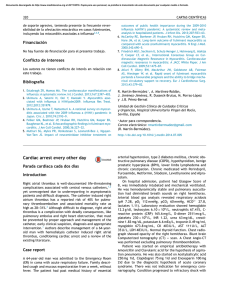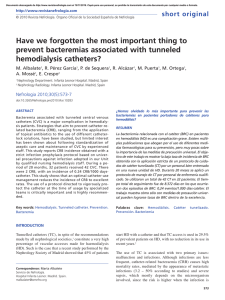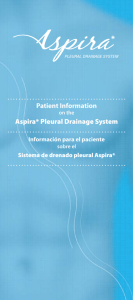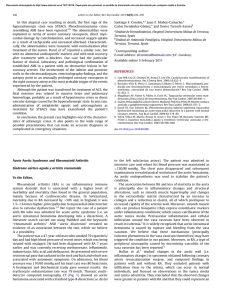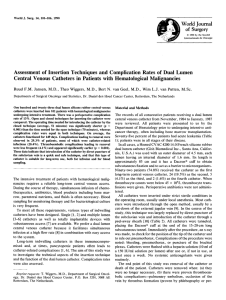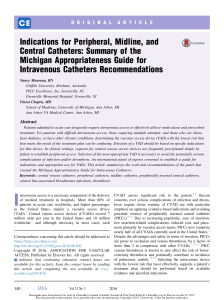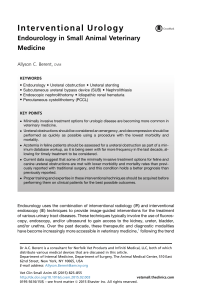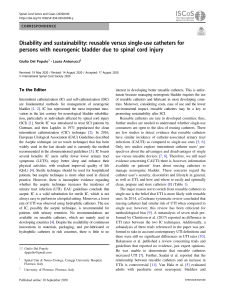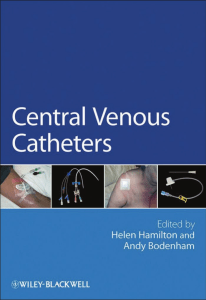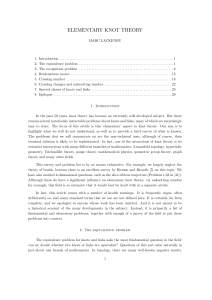CASOS CLINICOS-ingles--64
Anuncio
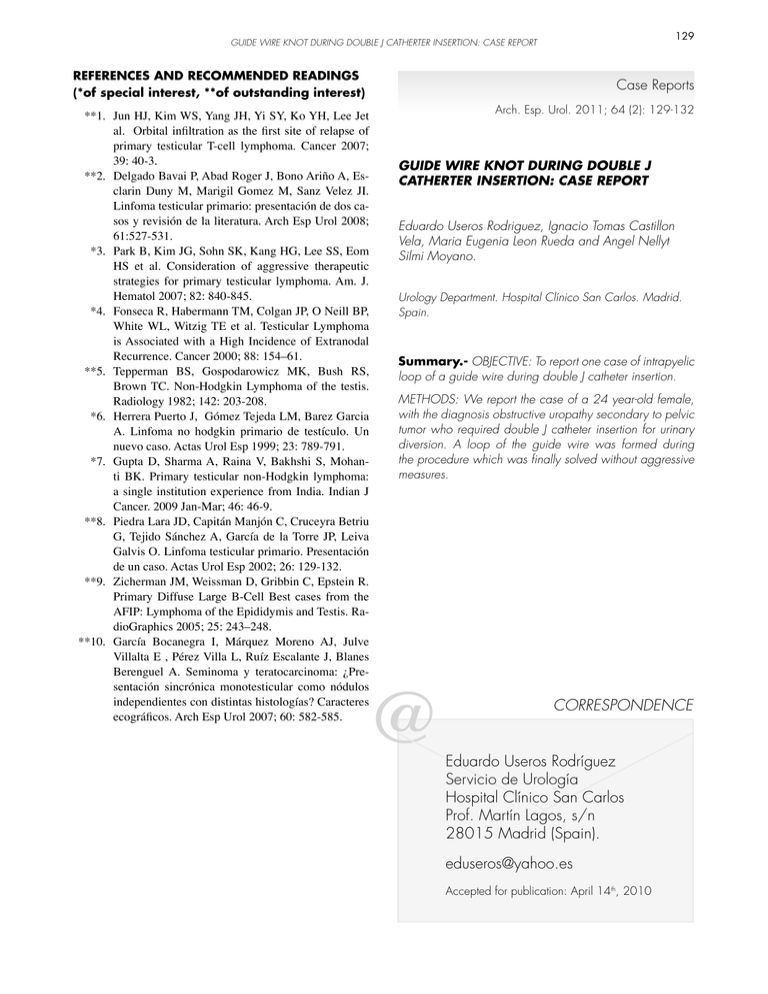
129 GUIDE WIRE KNOT DURING DOUBLE J CATHERTER INSERTION: CASE REPORT REFERENCES AND RECOMMENDED READINGS (*of special interest, **of outstanding interest) Case Reports **1. Jun HJ, Kim WS, Yang JH, Yi SY, Ko YH, Lee Jet al. Orbital infiltration as the first site of relapse of primary testicular T-cell lymphoma. Cancer 2007; 39: 40-3. **2. Delgado Bavai P, Abad Roger J, Bono Ariño A, Esclarin Duny M, Marigil Gomez M, Sanz Velez JI. Linfoma testicular primario: presentación de dos casos y revisión de la literatura. Arch Esp Urol 2008; 61:527-531. *3. Park B, Kim JG, Sohn SK, Kang HG, Lee SS, Eom HS et al. Consideration of aggressive therapeutic strategies for primary testicular lymphoma. Am. J. Hematol 2007; 82: 840-845. *4. Fonseca R, Habermann TM, Colgan JP, O Neill BP, White WL, Witzig TE et al. Testicular Lymphoma is Associated with a High Incidence of Extranodal Recurrence. Cancer 2000; 88: 154–61. **5. Tepperman BS, Gospodarowicz MK, Bush RS, Brown TC. Non-Hodgkin Lymphoma of the testis. Radiology 1982; 142: 203-208. *6. Herrera Puerto J, Gómez Tejeda LM, Barez Garcia A. Linfoma no hodgkin primario de testículo. Un nuevo caso. Actas Urol Esp 1999; 23: 789-791. *7. Gupta D, Sharma A, Raina V, Bakhshi S, Mohanti BK. Primary testicular non-Hodgkin lymphoma: a single institution experience from India. Indian J Cancer. 2009 Jan-Mar; 46: 46-9. **8. Piedra Lara JD, Capitán Manjón C, Cruceyra Betriu G, Tejido Sánchez A, García de la Torre JP, Leiva Galvis O. Linfoma testicular primario. Presentación de un caso. Actas Urol Esp 2002; 26: 129-132. **9. Zicherman JM, Weissman D, Gribbin C, Epstein R. Primary Diffuse Large B-Cell Best cases from the AFIP: Lymphoma of the Epididymis and Testis. RadioGraphics 2005; 25: 243–248. **10. García Bocanegra I, Márquez Moreno AJ, Julve Villalta E , Pérez Villa L, Ruíz Escalante J, Blanes Berenguel A. Seminoma y teratocarcinoma: ¿Presentación sincrónica monotesticular como nódulos independientes con distintas histologías? Caracteres ecográficos. Arch Esp Urol 2007; 60: 582-585. Arch. Esp. Urol. 2011; 64 (2): 129-132 GUIDE WIRE KNOT DURING DOUBLE J CATHERTER INSERTION: CASE REPORT Eduardo Useros Rodriguez, Ignacio Tomas Castillon Vela, Maria Eugenia Leon Rueda and Angel Nellyt Silmi Moyano. Urology Department. Hospital Clínico San Carlos. Madrid. Spain. Summary.- OBJECTIVE: To report one case of intrapyelic loop of a guide wire during double J catheter insertion. METHODS: We report the case of a 24 year-old female, with the diagnosis obstructive uropathy secondary to pelvic tumor who required double J catheter insertion for urinary diversion. A loop of the guide wire was formed during the procedure which was finally solved without aggressive measures. @ CORRESPONDENCE Eduardo Useros Rodríguez Servicio de Urología Hospital Clínico San Carlos Prof. Martín Lagos, s/n 28015 Madrid (Spain). eduseros@yahoo.es Accepted for publication: April 14th, 2010 130 E. Useros Rodríguez, I. T. Castillón Vela, M. E. León Rueda, et al. RESULTS: We report the case of a rare complication appeared during urinary catheter insertion procedure, as well as a review of the current literature. CONCLUSION: The use of guide wires and endourological catheters is not free of complications that may require aggressive measures to be solved. Keywords: Loop. Guide wire. Double J catheter. Urinary drainage. Resumen.- OBJETIVO: Presentar un caso de formación de un bucle intrapiélico en una guía endourológica durante la colocación de un catéter doble J. MÉTODOS: Presentamos el caso de una paciente de 24 años diagnosticada de una masa pélvica que produce uropatía obstructiva, en la que se produjo un nudo en la guía del catéter doble J durante el proceso de colocación, situación que se resolvió finalmente son recurrir a medidas agresivas. RESULTADOS: Presentamos el caso de una rara complicación de la cateterización de la vía urinaria y su solución, así como una revisión de la literatura al respecto de casos similares. CONCLUSIÓN: Los procesos de derivación endourológica de la vía urinaria no están exentos de complicaciones, de variado origen e importancia, y que pueden requerir medidas agresivas para su resolución. Palabras clave: Nudo. Guía. Cáteter doble J. Derivación urinaria. INTRODUCTION FIGURE 1. Intrapyelic loop of the catheter guide. indication for emergency left upper urinary tract drainage was set. Cistoscopy was done, showing ortotopic meatus. A straight ureteral catheter was introduced, reaching the renal pelvis with difficulty. Terumo® guide wire was introduced through the catheter. A double J catheter was then introduced over the guide wire after withdrawal of the straight catheter, reaching the renal pelvis. When we pulled the guide wire to withdraw it, a resistance was noticed that made it impossible. Fluoroscopic images showed a loop of the guide wire at the renal end of the double J (Figure 1). After several failed trials, loop was unlocked by means of back and forward movements of the Terumo“ guide under fluoroscopic image control (Figures 2,3,4). Finally, double J ends were properly set on pelvis and bladder (Figure 5). Double J ureteral catheter is a basic element for urinary drainage, used in many fields of Urology, from lithiasis to renal transplantation. Endourologic procedures such as ureteral catheterization are not free of complications. We describe a case of knot formation of a catheter guide wire during an emergency urinary drainage procedure. CASE REPORT 24 years old female with the diagnosis of pelvic highgrade chondrosarcoma, treated with chemotherapy after surgery rejection, with right hydronephrosis due to extrinsic compression drained with chronic double J ureteral catheter. A worsening in renal function was detected as a consequence of newly developed left hydronephrosis related with fast progression of her oncological disease. In the light of these findings FIGURE 2. Procedures to undo the knot. GUIDE WIRE KNOT DURING DOUBLE J CATHERTER INSERTION: CASE REPORT 131 DISCUSSION Urinary drainage by means of double J ureteral catheter is the favorite urological procedure to solve obstructive pathology of the upper urinary way compromising renal function. An early drainage of acute obstruction of the upper urinary tract is determinant for the recovery of renal function. There are other factors that contribute to the grade of recovery, such as patient`s age, grade of obstruction and base renal function. Diverse complications may happen during the catheterization procedure (1). It is not infrequent to find resistance to pass through the obstruction area (lithiasis, stenosis, extrinsic compression…); sometimes it is impossible, or we may cause an injury to the ureter, the resolution of which may require from watchful waiting to chirurgical correction. Sometimes, it is necessary to exert important pressure to push the catheter over the guide, and, in a few cases, this pressure ends up introducing pusher into the vesical end of the catheter, making impossible to separate both elements after guide wire withdrawal. When this happens, it may be necessary to take cystoscope out keeping catheter in place, and introduce it back in parallel to the pusher, and then use a pair of forceps to hold the end of the double J while pulling the pusher. Another possible problem is the ascent of the vesical end of the catheter into the ureter, needing to carry out ureterorenoscopy to retrieve it. In the present case, after a difficult insertion of the catheter, withdrawal of the guide was not possible due to the formation of a loop in the renal pelvis. Fortunately, the first impulse (pulling the guide strongly) was inhibited, and fluoroscopic image allowed to diagnose the problem. Many maneuvers were necessary to unlock the knot. If this had not been possible, we would FIGURE 3. Loop is finally managed to be undone. FIGURE 4. Catheter slides properly over the guide. have needed to withdraw both guide and catheter and try a new insertion. Knotting on guide wires and catheters has been described in the literature in endourologic procedures, central venous catheters and epidural analgesia catheters for pain control (2,3). Delgado Oliva et al. describe a similar case of a loop between a double J catheter and the guide wire (4) during ureteroscopy, which concluded with nephrectomy of the affected kidney. In our case, guide movements turned out to be enough to undo the loop without need of aggressive procedures. There have also been described cases of intravesical knotting between a urethral catheter and a suprapubic cystostomy catheter, that were both solved without agressive measures (5,6). FIGURE 5. Catheter stays properly set. 132 R. Molina Escudero, F. Herranz Amo, M.C. Navas Martínez, et al. CONCLUSIONS Case Reports The use of guide wires and catheters in endourology can entail complications during the procedures. Guide wire knotting is a rare complication the solution of which may require complex surgical interventions. Arch. Esp. Urol. 2011; 64 (2): 132-135 METASTATIC PROSTATE CANCER ON THE THYROID CARTILAGE: UNUSUAL SYMPTOMS OF PROSTATIC ADENOCARCINOMA. CASE REPORT REFERENCES AND RECOMMENDED READINGS (*of special interest, **of outstanding interest) **1. Vallejo Herrador J, Burgos Revilla FJ, Álvarez Alba J, Sáez Garrido JC, Tellez Martínez-Fornes M, Sánchez de la Muela P, et al. El catéter ureteral doble J. Complicaciones clínicas. Arch Esp Urol, 1998; 51(4):361-373. 2. Pacreu S, Soler E, González I. Nudo verdadero en la guía para vía central. Rev Esp Anestesiol Reanim, 2006;53(10):680. 3. 3. García-Saura PL, Castilla-Peinado G, Parras-Maldonado MT. Formación de un nudo verdadero en extemo distal de un catéter, tras su inserción para analgesia epidural obstétrica. Rev Esp Anestesiol Reanim, 2008; 55(4):256-7. *4. Delgado Oliva FJ, Bonillo García MA, Palmero Martí JL, Gómez Pérez L, Broseta Rico E, Jiménez Cruz JF. Bucle con catéter doble J en procedimiento endourológico: a propósito de un caso. Actas Urol Esp, 2006;30(3):331-4. 5. Carrillo-Esper R, Visoso-Palacios P, Suárez-Mendoza AC. Anudamiento de catéter Swan-Ganz en la rama derecha de la arteria pulmonary. Cir Cir, 2003; 71(3):229-34. Review. 6. Gonzálvez Piñera J, Fernández Córdoba M, Vidal Company A. Intravesical knot of Foley catheter: unusual complication of cystourethrography in children. An Esp Pediatr, 2000; 53(6):601-3. R. Molina Escudero, F. Herranz Amo, M.C. Navas Martinez1, J. Tabares Jimenez, A. Husillos Alonso, G. Ogaya Pinies and C. Hernandez Fernandez. Urology Service. Hospital General Universitario Gregorio Marañón. Madrid. Urology Service. Hospital Universitario Puerto Real. Cádiz. Spain. Summary.- OBJECTIVE: To review the unusual localizations of metastasic prostate cancer with the contribution of a clinical case of prostatic adenocarcinoma metastasis in the thyroid cartilage. METHODS: 49-year-old-male admitted with history of 48 hour hematuria associated with lumbar pain radiating to the lower extremities and cervical tumour for 3 months. @ CORRESPONDENCE Roberto Molina Escudero Urology Service Hospital General Universitario Gregorio Marañón Doctor, Esquerdo 46 28007 Madrid (Spain). robersescu@hotmail.com Accepted for publication: May 4th, 2010


